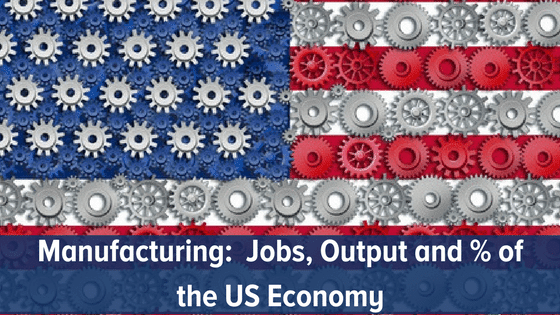
Every now and then we hear some news report of the decline of manufacturing, loss of jobs, and other related depressing headlines. Anyone interested in manufacturing is aware this is no longer the 1950’s and manufacturing jobs aren’t as plentiful as they were then—at least in the Rust Belt and other areas of the US. We found an article that puts all this into some perspective.
In the main, there’s a great deal of confusion that can be clarified by separating manufacturing jobs, manufacturing output, and what’s the manufacturing piece of the overall US economy. Two are down, but one is up. Here are some details.
Drew Desilver’s 7/25/17 article “Most Americans Unaware That as US Manufacturing Jobs Have disappeared, Output Has Grown” appeared in the Pew Research Center’s website. This article is full of interesting tidbits, sure to dazzle your friends who claim “we don’t make things anymore”. Oh yes we do, and lots of them—but with fewer of us! Here’s just a sample of what’s in this article:
- 4 of every 5 Americans know that the total number of manufacturing jobs in the US has decreased over the past 3 decades, but only about 1 in 3 know that the nation’s output has increased over the same period. One reason for this may be that the decline in manufacturing employment is highly visible, especially in areas with major plant closings. On the other hand, output growth is probably more diversified and less dramatic on an individual basis.
- As a share of the overall workforce, manufacturing has been dropping steadily ever since the Korean War ended, as other sectors of the US economy have expanded much faster. Manufacturing was 32.1% of total US employment in 1953; 8.5% today.
- Output-wise, US manufacturers made $5.4 trillion worth of goods and products (2009 dollars). Food, beverages, tobacco products, chemicals and motor vehicles and parts were the biggest sectors, totaling $2.2 trillion.
- After adjusting for inflation, manufacturing output in the first quarter of 2017 was more than 80% above that of 30 years ago. However, it represents a smaller share of the total economy than earlier: 23% of gross output in 1997, just 18.5% in 2016.
- Notable changes within manufacturing over the past 30 years: computer and electronics production is up 2600%. Motor vehicles and parts up 124%, apparel and leather goods down 85%; and textile production is down about 52%.
- The simultaneous increase in manufacturing output and decline in jobs over the long term shows that American manufacturers have become far more productive than they were 30 years ago. Among the many factors involved are replacing old equipment with newer, more advanced devices; workers becoming more skilled and educated, and firms improving their processes.
Recently we wrote about some of the issues associated with various jobs programs in the news. This article and the items listed above reinforce the notion that big federal programs would have some difficulty keeping track of the movement up and down of various manufacturing sectors in various locations.
If you are within easy travel of Cincinnati, you may be interested in Alan Beaulieu’s annual economic forecast for 2018 on 11/16/17 where he’s sure to comment on a number of these factors. Here’s the registration link for this FREE event: Register Now

